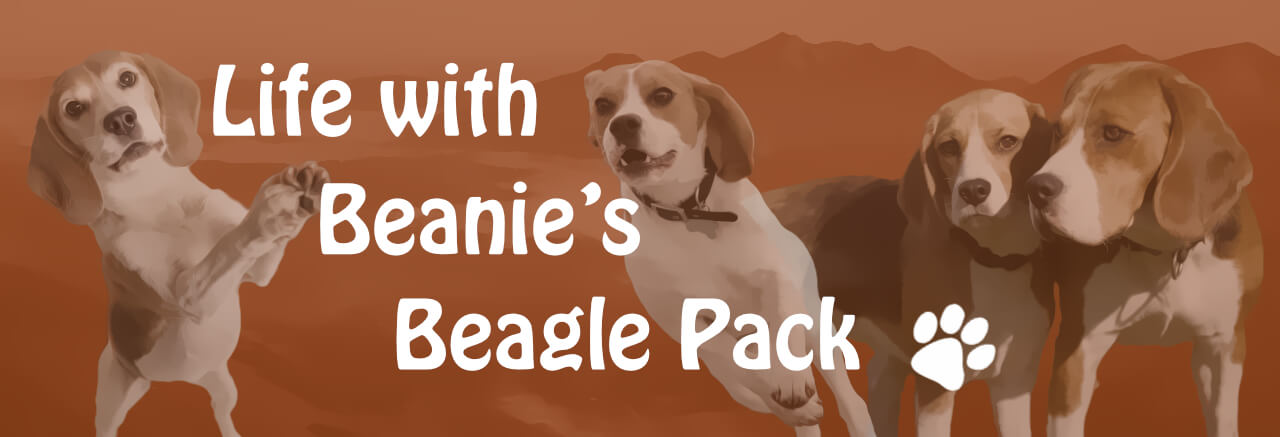Recently, Beanie’s been having what appeared to be an allergic reaction to… something. The skin on her legs, stomach, chest and snout became very itchy, and took on an angry shade of pink. Initially we kept it in check by using antihistamines and oatmeal baths, while we sought to eliminate possible irritants from her environment: carpet freshener, dust mites, pollen, grass etc.
Since food was also a possible cause, we changed her diet. She’s been on Burns Minibites since her early puppy days, and wanting to keep going with such a well-respected brand, we temporarily switched to Burns adult food – pork & potato – so she’d be getting completely different ingredients. She loved it, and wolfed down every bowlful. We switched to using the food for treats too, so pretty much the only thing she was eating (aside from the usual Beagle food snatching accidents) was her kibble.
Despite our efforts, her symptoms got gradually worse over the next week. The vet sent away blood samples for analysis, while we struggled to see any kind of pattern to the problem. Grass/pollen didn’t seem to fit, as we saw no appreciable difference whether she was at the beach or running on freshly cut grass in the park. Carpet freshener didn’t seem to be the culprit either – we’d already washed any residue away. Finally, although you can never eradicate dust mites from a house, we must surely have reduced Beanie’s exposure to them by very regular vacuuming and excluding Beanie from our bedroom during the day. What was left?
The only thing that fit the pattern of escalating irritation was Beanie’s food. By eliminating the normal range of treats, we’d actually concentrated her exposure to it. Admittedly we’d changed to a different product, but it was from the same manufacturer. We contacted Burns to see if they had any ideas or experience of this, and when we told them the amount of food Beanie was getting each day, they suggested we were overfeeding her, and that the excess of food could manifest itself as skin problems rather than weight gain. On the Burns site we found the following statements:
I CAN’T BE OVERFEEDING BECAUSE MY DOG IS NOT OVERWEIGHT
NO!! Many pets which are overfed do not put on weight because they discharge the excess rather than store it as fat. This discharge of excess tends to occur in those pets which are physically active. It is the less active ones which become overweight.
And:
MY PET HAS DRY, FLAKY SKIN. DOES HE NEED MORE OIL IN HIS DIET?
No! Dry, flaky skin (dandruff or scurf) is a sign that there is an excess of waste matter in the system. It is not a sign that anything is lacking in the diet. The solution is to feed a high quality diet in smaller amounts. This will enable the body to eliminate the waste matter and the skin condition will then improve.
We didn’t fancy reducing Beanie’s food intake – she’s nice and lean as it is, and it sounded really strange that overfeeding could cause skin problems. The way I understand it, food shouldn’t work that way. If you eat more than you burn through growth or exercise, you get fat. I’m carrying about a stone of flab around at the moment as proof of that! But even this fit the pattern, because the skin problems had started when we’d increased her intake slightly, following advice largely from people involved in showing their Beagles.
At the weekend we ditched Burns in favor of WafCol. Literally overnight we saw a reduction in the pinkness of her skin. This morning it was pretty much back to normal, and although her itching hasn’t gone completely, it’s much reduced.
WafCol food is even more expensive than Burns, and is famed for being a food that can be tolerated by even the most sensitive dogs. My guess is that almost any other food would have done – the key was just to get her off Burns food. I’m not saying that Burns food is bad, in fact for a long time Beanie really thrived on it and stayed lean, which is very desirable from a health and growth point of view. However, I’m having doubts about whether it’s a good choice for Beagles. Beagles have an insatiable appetite – if something’s edible, then it MUST be eaten! The normal way to determine if a dog has been overfeeding is to test its fat levels. In Beanie’s case, that test didn’t apply. She didn’t put on flab from overfeeding, she just had a whole lot of skin trouble.
I guess there are a few lessons to be learned from this:
- On most Dog forums, when you write in for help with skin problems, the first thing you’re advised to do is try changing your dog’s food. At this point I’d have to say that seems like good advice!
- If you try changing your dog’s food, change the brand, not just the recipe.
- Just because a food is expensive and well regarded doesn’t mean it’s going to be good for your dog.
